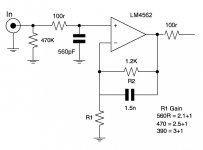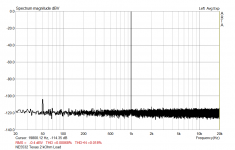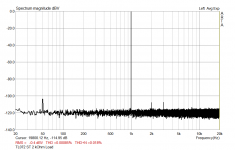VERY important to limit its use. It is NOT to be used in driving anything below ~10KΩ, or in any noise-critical circuit. Overall, the OPA1642 is a MUCH better choice. But it IS more expensive and SOIC only.
That is why I always say 'when used correctly'.
The real limitation is a somewhat limited drive ability, but we also have to be realistic and say that even though 2k loading is often suggested as a minimum value, that figure is one that allows full voltage swing when operating on nominal -/+15 volt supplies.
It is the current delivery that is a limitation, not the impedance itself. Given that most 'digital' source components deliver around 2 to 3 volts rms as a maximum that means the TL0xx series is quite happy with loads in the sub 600 ohm region... in that usage.
It's become fashionable to criticise this device over the last 10 to 15 years... all I would say is that it should be given a fair listen if the application is suitable.
My experience is that is can be very very good indeed when used after a DAC, possibly because of the supposed better immunity of the FET input stage to the HF hash present at many DAC outputs.
All anyone can do is try it 🙂
Yes - I've read a lot of your posts and I'll get hold of a TL072. Slew rate is same as 5534. Should I get the CP or ACP version?
I put a NE5532AP back in the DAC - it's a smoother and fuller sound. I have a few NE5532s and the AP version was the most expensive, don't know if that means better.
With the OPA2134 the DAC was more detailed but the sound lacked body. The OPA2228 didn't sound good in the DAC, and was the least good in the op-amp gain stage. In the gain stage it'll probably be LM4562 or OPA2134 for now. But in terms of single op-amps I have some to try - LT1028, OP27, AD845 and NE5534.
Unless they are used incorrectly and unless the op amp isn't suitable for audio applications, you can't hear differences between op amps - no one can.
Just a little thought experiment... Distortion in your speakers will typically be -40 to -60dB. When listening to music can you hear your ambient room noise? I mean just the hiss and vibrations. These are typically around 40dB. This means you'll have to be listening to music at 80 to 100dB to hear the distortion over the room noise! My argument is, if you can't hear the distortion of your speakers over the room noise, how do you expect to hear harmonics 100dB and below caused by op amps!!!???
It's simply insane!
That is why I always say 'when used correctly'.
The real limitation is a somewhat limited drive ability, but we also have to be realistic and say that even though 2k loading is often suggested as a minimum value, that figure is one that allows full voltage swing when operating on nominal -/+15 volt supplies.
It is the current delivery that is a limitation, not the impedance itself. Given that most 'digital' source components deliver around 2 to 3 volts rms as a maximum that means the TL0xx series is quite happy with loads in the sub 600 ohm region... in that usage.
It's become fashionable to criticise this device over the last 10 to 15 years... all I would say is that it should be given a fair listen if the application is suitable.
My experience is that is can be very very good indeed when used after a DAC, possibly because of the supposed better immunity of the FET input stage to the HF hash present at many DAC outputs.
All anyone can do is try it 🙂
Just measured a couple of examples to illustrate your argument. TI 5532P vs ST TL02CN Inverting configuration Gain=10 Output=1VRMS across 2kΩ Load. I kept the test output level at 0dBV to avoid visible THD contribution from the sound card. Best performing sample I have is a TL082CP vintage National Semiconductor by the way. Goes 0.00075% in same conditions.
Attachments
^ Interesting result, thanks for trying that. We probably all suspect there is always more to 'how they sound' than just raw numbers but its great to see an actual device tested.
The TL08x series were slightly higher noise if I recall correctly and were always passed over in favour of the TL07x series.
😎 I'm a real fan of these chips if I'm honest.
The TL08x series were slightly higher noise if I recall correctly and were always passed over in favour of the TL07x series.
😎 I'm a real fan of these chips if I'm honest.
Here's a sample of the opamp circuit I'll be using att. By all means criticise it!
Nothing to criticise so much... just observations 🙂
The 470k input resistor is fine but will allow a very small DC offset to appear at the output, an offset made worse by the fact the feedback return is DC coupled (so the offset voltage at the input is amplified by the circuit gain).
Also any DC already present in whatever you connect will also be amplified.
The feedback values are good for minimizing noise contribution and even at 2 to 3 volts RMS output will only 'consume' around 3ma peak or less of the available current the opamp can deliver.
You huys do also understand that the uman ears are as different then the opamps?
Of course, and that is why should always trust what you actually hear and not be just guided by numbers and fashion.
Thanks for that, Mooly. What value input resister should I use to replace 470K? I see a few circuits with 47K.
Thanks for the help guys, I feel like an imposter in the presence of you solid state gurus. All my experience is with tubes.
Thanks for the help guys, I feel like an imposter in the presence of you solid state gurus. All my experience is with tubes.
It all depends...
If the circuit was AC coupled at the input and output then 470k is perfect. It offers light loading and the noise contribution (in all cases) doesn't figure into things because it falls as you parallel the resistor with whatever you connect to the input.
If the circuit you are connecting the input to is direct coupled anyway (such as straight from another opamp stage) then you don't need the 470k at all because the driving source sets all the DC conditions and impedance.
AC coupling the opamp output is pretty much universally advised, value of cap dependent on what you intend to connect it to.
If the circuit was AC coupled at the input and output then 470k is perfect. It offers light loading and the noise contribution (in all cases) doesn't figure into things because it falls as you parallel the resistor with whatever you connect to the input.
If the circuit you are connecting the input to is direct coupled anyway (such as straight from another opamp stage) then you don't need the 470k at all because the driving source sets all the DC conditions and impedance.
AC coupling the opamp output is pretty much universally advised, value of cap dependent on what you intend to connect it to.
^ Interesting result, thanks for trying that. We probably all suspect there is always more to 'how they sound' than just raw numbers but its great to see an actual device tested.
The TL08x series were slightly higher noise if I recall correctly and were always passed over in favour of the TL07x series.
😎 I'm a real fan of these chips if I'm honest.
I also have vintage TL082CN from ST but they don't match the Nat Semi sample's performance. Nat draws 3.7mA quiescent when all other TL0xx I have draw 3.4mA. Could be doing well because its little hotter biased, could be due to superior fabrication. Looks like its not a TL072 vs TL082 type inherent thing.
By the way, the NE5532 tended to worsen easier than analogous* BJT input types I tested when in G=10 non-inverting mode. Could be having more common mode distortion. Because it presented visibly higher THD than the others, adding high order harmonics also. Such a thing did not happen when in same gain with same resistors inverting mode.
*I compared NJM2068 NJM4580 LM833 uPC4570
At such signal levels splendid. Nice square wave edges on the scope too, less peaky than most others in the raw. Only 3.3pF across a 10k R feedback in the G=10 inverting test mode sorted it out.
Used to have an expensive enough Denon CD Player in the 90s and I remember it sounding surprisingly great if with LM833 at its output, better than with anything different I had tried there. Its an easy going chip makes no fuss.
Used to have an expensive enough Denon CD Player in the 90s and I remember it sounding surprisingly great if with LM833 at its output, better than with anything different I had tried there. Its an easy going chip makes no fuss.
I also have vintage TL082CN from ST but they don't match the Nat Semi sample's performance. Nat draws 3.7mA quiescent when all other TL0xx I have draw 3.4mA. Could be doing well because its little hotter biased, could be due to superior fabrication. Looks like its not a TL072 vs TL082 type inherent thing.
By the way, the NE5532 tended to worsen easier than analogous* BJT input types I tested when in G=10 non-inverting mode. Could be having more common mode distortion. Because it presented visibly higher THD than the others, adding high order harmonics also. Such a thing did not happen when in same gain with same resistors inverting mode.
*I compared NJM2068 NJM4580 LM833 uPC4570
I'll bet a lot of production processes have changed over the years as many of these parts are now a few decades old.
The NJM2068 is another excellent chip and the LM833... well that has changed beyond recognition if you order the 'right' part. It changed from the original LM833 with its relatively slow complementary output stage to a faster quasi output using all NPN's.
Post#54
A Different Opamp Compensation Technique.
I have some screen shots of all these somewhere on the forum but finding them isn't easy now after all these years.
I think these were the ones, post 131 here. Check out the two LM833 versions and the TL084. Just re-reading this post it seems the dual and quad opamps had the outputs summed for maximum drive (which was relevant to the original thread):
Doug Selfs NE5532 Power Amp. Thoughts anyone !
Doug Selfs NE5532 Power Amp. Thoughts anyone !
I'll bet a lot of production processes have changed over the years as many of these parts are now a few decades old.
The NJM2068 is another excellent chip and the LM833... well that has changed beyond recognition if you order the 'right' part. It changed from the original LM833 with its relatively slow complementary output stage to a faster quasi output using all NPN's.
Post#54
A Different Opamp Compensation Technique.
I have some screen shots of all these somewhere on the forum but finding them isn't easy now after all these years.
Thanks. From what I saw in johnc124's post #66 there, the classic LM833N is better than the boosted LM833P between 0.4V to 2.2V RMS output. Much better in fact. No coincidence it also performed beautifully in my 1V RMS breadboard tests of 10x gain.
John Linsley Hood once commented that the (original of course) LM833 "could well be the best" of all the audio opamps available at the time.
Hmmmm......an interesting comment. The LM833 has very similar datasheet specs to an NE5532 (the 833 is a little quieter, the 5532 a little faster). I never could understand why Jim Williams, in his modification of the Dolby 363, used BOTH of them, each in a different part of the circuitry. The NE5532, of course, is probably the most-used fave of the pro-audio community up until ~ 2006 (when the LM4562 came out).John Linsley Hood once commented that the (original of course) LM833 "could well be the best" of all the audio opamps available at the time.
Mixing and matching may not be a bad thing.
If we say that opamps do have different sound... and if they don't then why are we bothering 😉 then it could be a smart move to not use all of the same type of device where any effects could be cumulative. Just a thought.
If we say that opamps do have different sound... and if they don't then why are we bothering 😉 then it could be a smart move to not use all of the same type of device where any effects could be cumulative. Just a thought.
Incidentally, did you know that the DIP LM833s are presently £3 or so at Farnell. So about the price of an OPA1612. Not sure why.
- Home
- Amplifiers
- Chip Amps
- The best sounding audio integrated opamps


